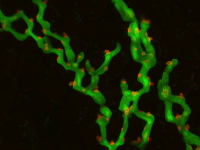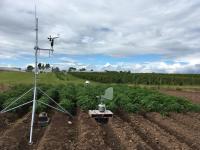
Potato IPM
Potato crops are adversely affected by many pests and pathogens. Novel research at The James Hutton Institute contributes to IPM through the development of effective control methods, genetic improvement of crops, diagnostics to inform decision making and improved management of inputs and resources. Control options are integrated to achieve the most effective and sustainable control of pests and pathogens of potato.

Breeding resistant cultivars
The commercial potato breeding programme at the James Hutton Institute utilises the genetic resources of the commonwealth potato collection through conventional and marker assisted breeding to develop host resistance to economically important pests and diseases, such as PCN and late blight in commercially acceptable cultivars.
For more information see Potato Genetics

Identifying host resistance/ effectors
Pathogen effector research combined with the exploitation of the potato genome is being used to identify novel and durable host resistances against late blight, PCN and PVY.
For more information see Effector consortium

Predictive diagnostics
By employing appropriate sampling strategies in conjunction with DNA extraction and molecular diagnostic techniques to detect and quantify target pathogens, we can validate the relationship between detectable inoculum and disease risk, enabling informed decisions on IPM to be made for soil-borne pests and pathogens and late blight.
For more information see Predictive diagnostics to underpin IPM of soil-borne potato diseases

Populations/modelling
Population monitoring of pests and pathogens is being used to identify pathogen resistance to fungicides and insectides in late blight and aphid populations respectively. Additionally, epidemiological models provide an insight into the spatial scale at which management interventions are most likely to be successful. An updated version of the UK national forecasting system for late blight "Hutton Critera" was recently released.
For more information see Epidemiological Modelling
Alternative control methods
Novel approaches to control pests and pathogens of potato are being investigated. For example, research is being undertaken into natural biofumigant chemicals to control FLNs and the associated TRV spraing disease. In addition, the use of bacteriophages (viruses that attack and kill bacteria) to control disease caused by Pectobacterium spp. is being studied.
For further information see Blackleg on Potato
